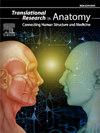肠内神经元和神经胶质的显微解剖;PGP9.5、S100b蛋白、RET和SOX10基因在人胎儿肠壁中的表达模式
Q3 Medicine
引用次数: 0
摘要
肠神经系统由肠神经元和神经胶质组成,它们来源于神经嵴细胞,并调节胃肠功能。先前的动物研究已经强调了RET和SOX10基因以及PGP9.5和S100b蛋白在神经元和胶质细胞发育中的重要作用。本研究探讨了这些基因和蛋白在人胎儿肠壁中的表达。方法采用苏木精和伊红、磷钨酸苏木精、Beilschowsky银和Masson三色染色法对人胎儿肠壁组织样本进行染色,观察神经元和神经胶质的组织形态学变化。采用免疫组织化学和qPCR分析PGP9.5、S100b蛋白、RET和SOX10基因的表达。结果人胎儿胃和小肠的神经元和神经节形态多样。在整个妊娠期,神经元从浆膜通过肌肉层迁移到粘膜下层。随着胎龄的增加,浆膜中的神经元和胶质细胞数量减少,而肌肉层和粘膜下层的神经元和胶质细胞数量增加。在妊娠早期,PGP9.5在浆膜中表达强烈,在结肠深层中表达适度。随着妊娠的推进,其在浆膜的表达减少,在内层的表达增强。S100b具有类似的模式,但在上皮中不存在。RET和SOX10基因的表达在妊娠中期和晚期增加。结论RET和SOX10基因以及PGP9.5和S100b蛋白的表达模式支持它们在人胎儿肠壁肠神经元和胶质细胞发育中的作用。本文章由计算机程序翻译,如有差异,请以英文原文为准。
Microanatomy of the enteric neurons and glia; expression patterns of the PGP9.5, S100b proteins, RET and SOX10 genes in the human fetal gut wall
Background
Enteric nervous system comprises enteric neurons and glia, derived from neural crest cells, and regulates the gastrointestinal function. Previous animal studies have highlighted the essential roles of RET and SOX10 genes, along with PGP9.5 and S100b proteins, in the development of neurons and glia. This study investigates the expression of these genes and proteins in the human fetal gut wall.
Methods
Tissue samples of the human fetal gut wall were stained using haematoxylin and eosin, phosphotungstic acid haematoxylin, Beilschowsky silver, and Masson's trichrome to examine the histomorphology of neurons and glia. Immunohistochemistry and qPCR were used to analyse the expression of PGP9.5, S100b proteins, RET and SOX10 genes.
Results
Human fetal stomach and small intestine showed diverse neuronal and ganglionic morphologies. Neuronal migration occurred from the serosa through the muscle layers to the submucosa throughout all trimesters. As fetal age advanced, the number of neurons and glia decreased in the serosa and increased in the muscle layers and submucosa. PGP9.5 showed strong expression in the serosa and moderate expression in the deeper layers of the colon during the first trimester. Its expression diminished in the serosa and intensified in the inner layers with advancing gestation. S100b followed a similar pattern but was absent in epithelium. Expression of RET and SOX10 genes increased during the second and third trimesters.
Conclusion
The expression patterns of RET and SOX10 genes, and PGP9.5 and S100b proteins support their roles in the development of enteric neurons and glia in the human fetal gut wall.
求助全文
通过发布文献求助,成功后即可免费获取论文全文。
去求助
来源期刊

Translational Research in Anatomy
Medicine-Anatomy
CiteScore
2.90
自引率
0.00%
发文量
71
审稿时长
25 days
期刊介绍:
Translational Research in Anatomy is an international peer-reviewed and open access journal that publishes high-quality original papers. Focusing on translational research, the journal aims to disseminate the knowledge that is gained in the basic science of anatomy and to apply it to the diagnosis and treatment of human pathology in order to improve individual patient well-being. Topics published in Translational Research in Anatomy include anatomy in all of its aspects, especially those that have application to other scientific disciplines including the health sciences: • gross anatomy • neuroanatomy • histology • immunohistochemistry • comparative anatomy • embryology • molecular biology • microscopic anatomy • forensics • imaging/radiology • medical education Priority will be given to studies that clearly articulate their relevance to the broader aspects of anatomy and how they can impact patient care.Strengthening the ties between morphological research and medicine will foster collaboration between anatomists and physicians. Therefore, Translational Research in Anatomy will serve as a platform for communication and understanding between the disciplines of anatomy and medicine and will aid in the dissemination of anatomical research. The journal accepts the following article types: 1. Review articles 2. Original research papers 3. New state-of-the-art methods of research in the field of anatomy including imaging, dissection methods, medical devices and quantitation 4. Education papers (teaching technologies/methods in medical education in anatomy) 5. Commentaries 6. Letters to the Editor 7. Selected conference papers 8. Case Reports
 求助内容:
求助内容: 应助结果提醒方式:
应助结果提醒方式:


